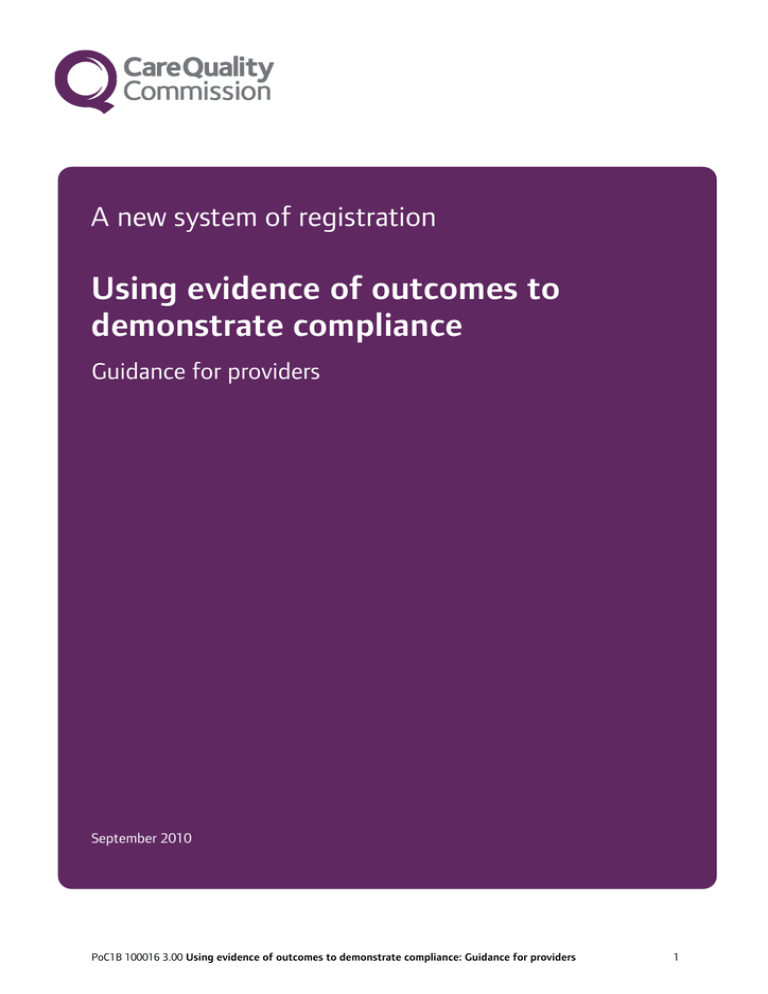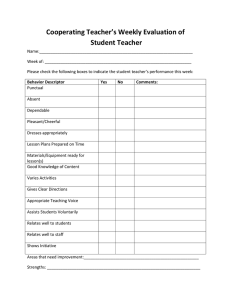Using evidence of outcomes to demonstrate compliance: Guidance
advertisement

A new system of registration Using evidence of outcomes to demonstrate compliance Guidance for providers September 2010 PoC1B 100016 3.00 Using evidence of outcomes to demonstrate compliance: Guidance for providers 1 Introduction The essential standards of quality and safety include the outcomes that people who use services should experience when they use registered health and adult social care services. This guidance will help you to identify the types of evidence that you can use to demonstrate that you are achieving these outcomes. You should read this guidance in conjunction with: • Guidance about compliance: Essential standards of quality and safety. • Guidance about compliance: Judgement framework. Guidance 1 Why is it important to have evidence of outcomes? Our publication Guidance about compliance: Essential standards of quality and safety describes the outcomes that people who use your services should experience. When we monitor your compliance with the essential standards, we will check that you are meeting these outcomes. We will focus on evidence which demonstrates that people who use services: • Have good outcomes and experiences, meaning that their care is effective and that they are safe. • Are involved in their care and that their views are listened to and acted on. By focusing on outcomes rather than looking only at a provider’s policies and procedures, we can assess health and social care services in a way that is centred on people who use services. This means actually considering the effect that a service has on people. 2 What factors will affect the evidence a provider uses? The outcomes that we set out in Essential standards of quality and safety are the same for all types of provider. However, the way different providers demonstrate that they are achieving these outcomes may vary. For example, the evidence a provider uses may be influenced by: PoC1B 100016 3.00 Using evidence of outcomes to demonstrate compliance: Guidance for providers 2 • The size of a service. • The range and complexity of the services provided. • The needs and number of people who use a service. • The range of staff and how they work together. • The arrangements in place to identify and manage risks. • The arrangements in place to collect and monitor information about quality and safety. It is also important that, as far as possible, the evidence: • Covers all of the services provided. • Is current and accurate. • Relates to all groups of people who use the service and takes account of diversity. The evidence you use will also depend on whether you are: 3 • An existing provider: once registered, or if you are an existing provider that is new to the scope of registration, you should use evidence of outcomes when assuring yourself that all your services at all of your locations continue to meet the essential standards. • A new provider: if you are in the process of setting up a new service you will need to assure us that you will meet the essential standards of quality and safety when it is operating. You will need to locate any proxy evidence to demonstrate that you will achieve the outcomes for people who will use your service. Are there any examples of sources and types of evidence? If your service is large and provides complex services, you will probably need to use evidence from a variety of different sources and in many different formats. You could use evidence directly from people who use services and those acting on their behalf, such as: • Surveys of people who use services, their carers and families. • Complaints and feedback from people who use services. • Patient reported outcome measures (PROMs). • Feedback from local representative, community and voluntary groups. • Feedback from the public. PoC1B 100016 3.00 Using evidence of outcomes to demonstrate compliance: Guidance for providers 3 • Involvement activity, such as focus groups. You could also use other evidence that may demonstrate outcomes for people directly or indirectly, such as: • Staff surveys and feedback. • Quality monitoring including reviews of services, learning from complaints, audits and comparative information. • Risk assessments. • Individual care planning and records. • Staff skills and competence. • Reporting and learning from incidents. • Equalities monitoring and action plans. • Information from regulators, inspections or accreditation schemes. • Action plans and monitoring improvements. From the broad range of information available, you should focus particularly on evidence that: • Comes directly from people who use services and those acting on their behalf. • Relates to the experiences of individual people who use the service. Your evidence should also demonstrate: • How you assess people’s needs appropriately and adequately, and how these needs are met. • How you address and minimise risks to the health, welfare and safety of people. • How you listen to and act on feedback. • The results of improvements made following changes in practice. You can use the Provider Compliance Assessment tool to help you to demonstrate your compliance with outcomes. 4 Can policies, procedures and systems be used as evidence of outcomes? As well as evidence that relates directly to outcomes, you can also demonstrate compliance with the outcomes using evidence that relates to your policies, procedures and systems. If you are a new provider applying to be registered, you are unlikely to have direct evidence of outcomes for people. Therefore, you will PoC1B 100016 3.00 Using evidence of outcomes to demonstrate compliance: Guidance for providers 4 particularly need to use policies and procedures as proxy evidence that, when the service is running, people will receive care that meets the outcomes in the essential standards of quality and safety. You should remember that simply having policies, procedures and systems in place is not sufficient to demonstrate compliance. Instead, these should demonstrate that you have taken steps to ensure that people’s needs are met and that they experience the required outcomes. Therefore, when you use evidence of policies, procedures and systems, you should also demonstrate how: • They impact on the outcomes and experiences of people using the service, and how this is monitored. • They help to meet people’s needs. • They help identify and manage risks to the health, welfare or safety of people. • They are implemented where necessary and their effectiveness monitored. • They are explained and made available to all relevant staff. • People who use the service were consulted and involved in their development. • They are reviewed and updated to ensure that you continue to be compliant. • You gather feedback about their impact from people who use services. Examples of evidence that might particularly be used in this way include policies, procedures and systems that relate to: • Staffing levels, and learning and development plans. Evidence relating to staff should demonstrate how you have taken account of the needs and diversity of people who use the service. The evidence must show how the policies ensure that appropriate staff with the necessary skills and competence to meet people’s needs are available at different times. We want to see evidence that these plans are up to date and that they are monitored and reviewed when needed. • Systems for reporting and learning from incidents. You need to have evidence not only that you have appropriate systems, but also that all relevant staff fully understand them and use them correctly. You need to show that these systems are more than just a record. They should enable you to identify and analyse individual incidents and trends for risks to people who use the service and staff. You will also need to demonstrate that, if there is an incident, you make clear action plans and implement them and that this leads to change, reduced risk and improved outcomes. • Safeguarding procedures. It is crucial that you can demonstrate that you have the right system in place and that this is understood by all relevant staff. You must be sure that it is followed in practice and that PoC1B 100016 3.00 Using evidence of outcomes to demonstrate compliance: Guidance for providers 5 staff take the right steps to protect people from abuse and the risks of abuse. You should also demonstrate that you frequently review these procedures to ensure they are effective in protecting people from abuse. 5 Will CQC expect providers to have evidence of outcomes straight away? When you evaluate your own compliance, we expect you to focus on evidence that relates to outcomes for people. However, we recognise that you may not be collecting direct outcome evidence for all services or all outcomes. Therefore, we anticipate a greater initial emphasis on evidence from policies, procedures and systems. As stated above, where it is appropriate to use evidence of policies, procedures and systems, always consider this in relation to the impact that they have on people who use your service. As the system for ongoing monitoring of compliance is embedded, we will increasingly expect you to gather and use evidence that directly demonstrates outcomes or comes directly from people who use your service. We recommend that you think about how you can collect this type of evidence and ensure you can routinely monitor your own compliance with the outcomes. This will mean that when we come to undertake a planned or responsive review of compliance for your location(s), you can be better prepared to demonstrate your compliance. PoC1B 100016 3.00 Using evidence of outcomes to demonstrate compliance: Guidance for providers 6


